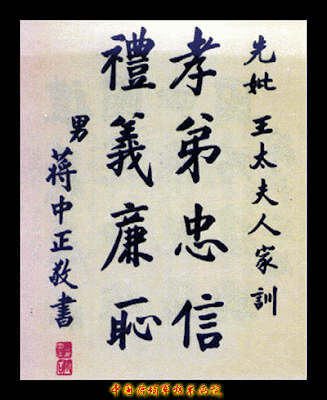Most of China's contemporary leaders are/were good at calligraphy, and Chiang Kai-shek (Jiang Jieshi, 1887 – 1975) was one of them.
Chiang Kai-shek was a political and military leader of 20th century China. At the age of 18 he went to military training college in Japan. He returned to China in 1911, took part in the uprising that overthrew the Qing Dynasty and became a member of the Chinese Nationalist Party (known as the Kuomintang or KMT).
He became the Commandant of Kuomintang's Whampoa Military Academy in 1924 and took Sun Yat-sen's place in the party when the latter died in 1925. In 1928, Chiang led the Northern Expedition to unify the country, becoming China's overall leader. He served as chairman of the National Military Council of the Nationalist Government of the Republic China (ROC) from 1928 to 1948. After the Japanese surrender in 1945, the Chinese Communist Party defeated the Nationalists in 1949, forcing the Nationalist government to retreat to Taiwan. Chiang ruled the island with an iron fist as the President of the Republic of China and Director-General of the Kuomintang until his death in 1975.
There is an old Chinese saying that calligraphy is a mirror to a person's character. It is therefore said that the calligraphy of leaders reflects the different characters that ruled the nation, and even their leadership abilities.
Chiang’s style of calligraphy is characterized by strong bones and precise constructions, as neat and orderly as that of Emperor Huizong (1082-1135) of the Song Dynasty (960-1279). On the other hand, differences are apparent. Huizong's ‘slender gold’ style featured thin and sturdy strokes, a poised and graceful style that attracted numerous followers. Chiang's was neat in formation and prudent, but not so creative. His handwriting was always even and orderly, irrespective of whether he was in a high or low mood. This shows he was careful about obeying regulations, but restricted by convention.
Mao Zedong defeated Chiang in military matters and also outperformed him in calligraphy. When writing, Mao let his feelings carry his brush freely, creating a new calligraphic vista. Reading his cursive style handwriting, people immerse themselves in the flow of strokes, slow or fast, dense or not dense. Readers are attracted by the aura his works create, as well as by his presence as the top leader.
蒋介石是中国二十世纪的一个政治与军事领袖。十八岁前往日本就读军事学校。1911年回国加入推翻清政府的革命,成为中国国民党党员。
1924年担任黄埔军校校长,1925年孙中山逝世,他就取代了孙中山在国民党的地位。1928年发动北伐战争,成为中国最高领袖。1928年至1948年,他担任中华民国国民政府的军事委员会主席。1945年日本投降后,中国共产党于1949年击败国民党,迫使国民政府退守台湾。从此,蒋介石以其铁腕统治台湾,担任中华民国总统与国民党主席,直到1975年逝世为止。
中国一句话说,书法反映一个人的个性。因此领袖的书法亦反映国家统治者的不同个性与他们的领导能力。
蒋的书法特性是笔画刚强,结构精确,与宋朝(960-1279)徽宗(1082-1135)的字一样整齐有序。他们之间也有不同。徽宗的‘瘦金体’的笔画细又有力,平衡而优雅的风格吸引不少追随者。蒋的书法排列整齐与谨慎,但是缺少创造力。不论他的心情如何,他的字写来都均匀与整齐。这显示他谨慎守法,拘谨于常规。
在军事上,毛泽东打败了蒋介石,在书法上亦是如此。毛让他的感情随意的控制毛笔,创造了书法新景象。观读他的草书,人们会融入他那快与慢、疏与密的线条节奏之中。读者会为其作品的气势所吸引,并感受到他作为最高领袖的存在。


















